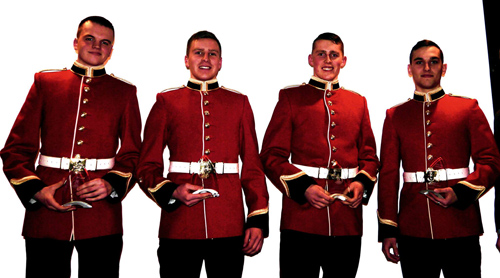 RMC Officer Cadets Andrew Lumley, Luke Tamlin, Jeremy Billard and Simon Ewing received their second place awards at the Canadian Engineering Competition in St. John’s, Newfoundland.
RMC Officer Cadets Andrew Lumley, Luke Tamlin, Jeremy Billard and Simon Ewing received their second place awards at the Canadian Engineering Competition in St. John’s, Newfoundland.On March 5th 2015, four second year engineering students from the Royal Military College of Canada, OCdt Andrew Lumley, OCdt Jeremy Billard, OCdt Luke Tamlin and OCdt Simon Ewing, travelled to St. John’s, Newfoundland, to participate in the 2015 Canadian Engineering Competition (CEC). The RMC cadets were representing not only the College, but the province of Ontario as well at the Competition. This year’s competition was at Memorial University of Newfoundland.
The annual competition allows university students from across Canada to compete against one another in any of the seven different categories, such as communications, re-engineering, and design. RMC sends two teams to compete at the Ontario Engineering Competition (OEC), held annually in February, one in each the junior and the senior design categories. In the design category, competitors are given a problem that one might encounter in a real engineering situation. Within six hours, each team not only has to create a design to fulfill the objectives, but must also build a prototype and prepare a presentation based on their work, which is presented to judges later on. Out of 17 teams that competed in the OEC junior design category, RMC finished in second place, securing a spot at the CEC. Only the top two teams from each of the four regions (the Western provinces, Ontario, Quebec, and the Atlantic provinces) get to advance to the national competition.
The challenge for the junior design at this year’s CEC was for competitors to design and build a prototype that could be mounted onto a remote control boat and could collect small floating balls in a large water tank. The given concept was to simulate a device that could be fitted to large ships and could collect floating pollution in the world’s oceans. As soon as the clock started, all eight teams quickly went to work at designing their projects. Most teams went about designing a solid half hoop which could be mounted to the back of the boat and push garbage along as it caught it; however, RMC took a slightly different approach compared to most of the other teams. RMC’s project relied on two plastic sheets that started on each side of the boat and converged about a foot behind it. A mesh net was fitted to an open ring where the two sheets met, and the idea was that as the debris hit the sides, it would be fed into the bag and retained there. Additionally, styrofoam floats were fitted to the side of the contraption to allow collection at several different depths, rather than just at the surface. The presentation that was later given not only outlined the pros and cons of the design, but also how it could be reproduced to operate in a real world setting.
The results of the competition were announced to competitors at the closing dinner on the Saturday night. Out of the eight teams from across Canada competing in junior design, RMC took home the second place standing once again.
On behalf of the RMC junior design team, I would like to take this opportunity to thank the RMC Foundation for providing the funding for RMC Officer Cadets to take part in these extremely enriching competitions.
OCdt 26987 (II) Simon Ewing